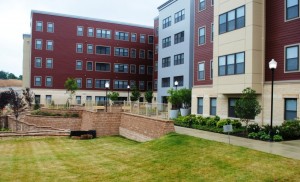About the New Communities Initiative
The New Communities Initiative “(NCI)” is a District government program designed to revitalize severely distressed subsidized housing and redevelop communities plagued with concentrated poverty, high crime, and economic segregation. The initiative targets four neighborhoods in the District of Columbia, including Barry Farm in Ward 8, Lincoln Heights/Richardson Dwellings in Ward 7, Northwest One in Ward 6 and Park Morton in Ward 1. The New Communities Initiative is funded through public bond financing that allows the District to leverage funding for development projects. NCI is managed by the District of Columbia Office of the Deputy Mayor for Planning and Economic Development “(DMPED)”, in partnership with the DC Housing Authority “(DCHA).”
New Communities began in 2005 as a local response to neighborhood redevelopment in the wake of federal budget cuts to housing revitalization programs and increasing crime and poverty in District neighborhoods. In FY2004 and FY2005, the George W. Bush administration’s budget submissions proposed eliminating the HOPE VI program, a major driver of neighborhood transformation throughout the 1990s and early 2000s. HOPE VI was a $6 billion initiative launched in 1992 by the US Department of Housing and Urban Development to redevelop troubled public housing projects. The program represented a new approach to federal housing policy that was codified into law through legislation signed by President Bill Clinton in 1998 known as the Quality Housing and Work Responsibility Act. Both the legislation and the concurrent implementation of the HOPE VI program sought to reduce the concentration of poverty in urban neighborhoods by raising the quality and standards for public housing stock, providing supportive services and employment opportunities to residents, and developing mixed-income communities. Recognizing that annual congressional appropriations to the HOPE VI program were rapidly decreasing, along with the increasing urgency to address poverty, crime and inadequate housing in some of the District’s poorest neighborhoods known as “hot spots”, the then District of Columbia Mayor Anthony A. Williams administration led the effort to create the New Communities Initiative.
The planning process included government officials, residents, community stakeholders, advocates and technical advisors. Through a series of public meetings, working groups and charettes, the vision and redevelopment plans for New Communities were developed.
The vision for the New Communities Initiative is for vibrant mixed-income neighborhoods that address both the physical architecture and human capital needs, where residents have quality affordable housing options, economic opportunities and access to appropriate human services. Four guiding principles lay the framework for New Communities.
- One for One Replacement to ensure that there is no net loss of affordable housing units in the neighborhood.
- The Opportunity for Residents to Return/Stay in the Community to ensure that current residents will have a priority for new replacement units in an effort to remain in their neighborhood.
- Mixed-Income Housing to end the concentration of low-income housing and poverty.
- Build First, which calls for the development of new housing to begin prior to the demolition of existing distressed housing to minimize displacement.
As a result of the community planning process, redevelopment plans were created and adopted by the DC Council for each of the four neighborhoods selected as part of the initiative. The initial redevelopment plans were adopted by DC Council in 2006, with the exception of Park Morton, which was adopted by DC Council in 2008. Each plan has two main components that are co-dependent upon each other for the success of the initiative: physical redevelopment, and human capital.
The physical redevelopment component of these plans call for the demolition of over 1,500 distressed housing units over the four New Communities neighborhoods and the replacement of these units with mixed-income housing. To help achieve these goals, the New Communities Initiative is funded through public bond financing that allows the District to leverage funding for development projects. To date, 250 units have been demolished and a total of 1,070 units have come online or are currently under construction. This redevelopment is the result of $66 million in public investment that has been leveraged with over $240 million of private funding. The redevelopment plans also call for a host of community amenities including new schools, recreation centers and retail. The modernization of the new HD Woodson High School, the new Walker-Jones Education Campus, and the new 32,000 square foot recreation center at Barry Farm, in addition to office space, retail space, parks and playgrounds are all examples of integral community amenities that have been developed under the New Communities Initiative.
The human capital component of New Communities is a critical element of the initiative and focuses on providing supportive services to residents to help households achieve self-sufficiency. The District partners with service providers to provide comprehensive case management services to New Communities residents. Health and wellness, employment, education, financial literacy and parenting are among the robust services that are offered to residents. Service providers are funded by the District through the New Communities human capital grant program.
